The share of TV ad spending stagnated or decreased by 1-4% in most countries, except for Ukraine, where it grew by 4%. The growth was the result of the fact that since the beginning of the Russian-Ukrainian crisis, the GDP increased for the first time in 2016 and that had a positive effect on the local media market as well. Total advertising spending grew by 27% (resulting in one of the highest growth rates in Europe) and TV ad spending increased to an even greater extent: by 36%. After the years of crisis, advertisers started to spend on TVCs at such a pace that advertising slots were sold out almost 100% between September and December 2016. From this ensues that while Ukraine took sixth place in the regional TV ranking last year (following Romania, Bulgaria, Serbia, Croatia and Slovenia), it finished fourth this year and with that, the ruling of the Balkan states is over. Speaking of which: 2016 not only brought financial changes to the Ukrainian TV market, but cultural ones as well. To bring Russian influence to an end, a law was passed according to which media channels have to broadcast 75% of their programs in Ukrainian.
The first place of the ranking is still occupied by Romania, where television is still the favorite medium of advertisers due to its relatively cheap time slots and high reach (Romanians watch TV for more than 5 hours a day on an average). It is true to such an extent that 64% of the total ad spending goes to TVCs, and time slots were sold out almost entirely on all channels in 2016 (just like in 2015). Romania also saw legislative changes that had an effect on the TV market. In April 2017, the government emergency order (passed in 2013) – restricting the intermediary role of media agencies between channels and advertisers – was abolished completely.
 It comes as no surprise that high TV ad spending goes hand in hand with high TV viewing time in most countries. However, this is not the case in Bulgaria that follows Romania on the list. It strikes the eye that while 56% of the advertising spending is spent on TV commercials, an average Bulgarian person watches TV “only” 2.5-3 hours a day (or at least the TV is switched on for that duration), which varies from the 4+ hours average of the region. weCAN’s Bulgarian media experts believe that this contradiction occurs due to the business interests of media players, not because of the channels’ viewing figures. Legend has it in Bulgaria that the two big local media enterprises, Nova Broadcasting Group and bTV Media Group, will be sold so the two groups fight fiercely to bring better results. Consequently, they convince their clients with the help of special offers and discounted package prices to purchase TV ad slots as well besides investing in advertising platforms in other mediums.
Among the Balkan countries, Slovenia experienced major TV market changes: since the autumn of 2016, time-shift viewing is considered in the pricing of every bigger TV channel, whether viewers fast forward ads or not. In addition, the two major commercial TV groups ceased the terrestrial broadcast of two channels. Even though Croatian media market figures do not differ significantly from that of last year, the situation can easily change by next year. The biggest Croatian private company, Agrokor, producing 15% of the country’s GDP, was hit by a grave financial crisis recently and this can have enormous consequences for the Croatian economy as a whole. Since Agrokor companies had belonged to the largest ad spenders on the local market, the crisis of the group will probably leave its mark on the performance of the local media and advertising market as well.
It comes as no surprise that high TV ad spending goes hand in hand with high TV viewing time in most countries. However, this is not the case in Bulgaria that follows Romania on the list. It strikes the eye that while 56% of the advertising spending is spent on TV commercials, an average Bulgarian person watches TV “only” 2.5-3 hours a day (or at least the TV is switched on for that duration), which varies from the 4+ hours average of the region. weCAN’s Bulgarian media experts believe that this contradiction occurs due to the business interests of media players, not because of the channels’ viewing figures. Legend has it in Bulgaria that the two big local media enterprises, Nova Broadcasting Group and bTV Media Group, will be sold so the two groups fight fiercely to bring better results. Consequently, they convince their clients with the help of special offers and discounted package prices to purchase TV ad slots as well besides investing in advertising platforms in other mediums.
Among the Balkan countries, Slovenia experienced major TV market changes: since the autumn of 2016, time-shift viewing is considered in the pricing of every bigger TV channel, whether viewers fast forward ads or not. In addition, the two major commercial TV groups ceased the terrestrial broadcast of two channels. Even though Croatian media market figures do not differ significantly from that of last year, the situation can easily change by next year. The biggest Croatian private company, Agrokor, producing 15% of the country’s GDP, was hit by a grave financial crisis recently and this can have enormous consequences for the Croatian economy as a whole. Since Agrokor companies had belonged to the largest ad spenders on the local market, the crisis of the group will probably leave its mark on the performance of the local media and advertising market as well.
 It comes as no surprise that high TV ad spending goes hand in hand with high TV viewing time in most countries. However, this is not the case in Bulgaria that follows Romania on the list. It strikes the eye that while 56% of the advertising spending is spent on TV commercials, an average Bulgarian person watches TV “only” 2.5-3 hours a day (or at least the TV is switched on for that duration), which varies from the 4+ hours average of the region. weCAN’s Bulgarian media experts believe that this contradiction occurs due to the business interests of media players, not because of the channels’ viewing figures. Legend has it in Bulgaria that the two big local media enterprises, Nova Broadcasting Group and bTV Media Group, will be sold so the two groups fight fiercely to bring better results. Consequently, they convince their clients with the help of special offers and discounted package prices to purchase TV ad slots as well besides investing in advertising platforms in other mediums.
Among the Balkan countries, Slovenia experienced major TV market changes: since the autumn of 2016, time-shift viewing is considered in the pricing of every bigger TV channel, whether viewers fast forward ads or not. In addition, the two major commercial TV groups ceased the terrestrial broadcast of two channels. Even though Croatian media market figures do not differ significantly from that of last year, the situation can easily change by next year. The biggest Croatian private company, Agrokor, producing 15% of the country’s GDP, was hit by a grave financial crisis recently and this can have enormous consequences for the Croatian economy as a whole. Since Agrokor companies had belonged to the largest ad spenders on the local market, the crisis of the group will probably leave its mark on the performance of the local media and advertising market as well.
It comes as no surprise that high TV ad spending goes hand in hand with high TV viewing time in most countries. However, this is not the case in Bulgaria that follows Romania on the list. It strikes the eye that while 56% of the advertising spending is spent on TV commercials, an average Bulgarian person watches TV “only” 2.5-3 hours a day (or at least the TV is switched on for that duration), which varies from the 4+ hours average of the region. weCAN’s Bulgarian media experts believe that this contradiction occurs due to the business interests of media players, not because of the channels’ viewing figures. Legend has it in Bulgaria that the two big local media enterprises, Nova Broadcasting Group and bTV Media Group, will be sold so the two groups fight fiercely to bring better results. Consequently, they convince their clients with the help of special offers and discounted package prices to purchase TV ad slots as well besides investing in advertising platforms in other mediums.
Among the Balkan countries, Slovenia experienced major TV market changes: since the autumn of 2016, time-shift viewing is considered in the pricing of every bigger TV channel, whether viewers fast forward ads or not. In addition, the two major commercial TV groups ceased the terrestrial broadcast of two channels. Even though Croatian media market figures do not differ significantly from that of last year, the situation can easily change by next year. The biggest Croatian private company, Agrokor, producing 15% of the country’s GDP, was hit by a grave financial crisis recently and this can have enormous consequences for the Croatian economy as a whole. Since Agrokor companies had belonged to the largest ad spenders on the local market, the crisis of the group will probably leave its mark on the performance of the local media and advertising market as well.












